高级微观经济学习题 参考
- 格式:doc
- 大小:1.90 MB
- 文档页数:18
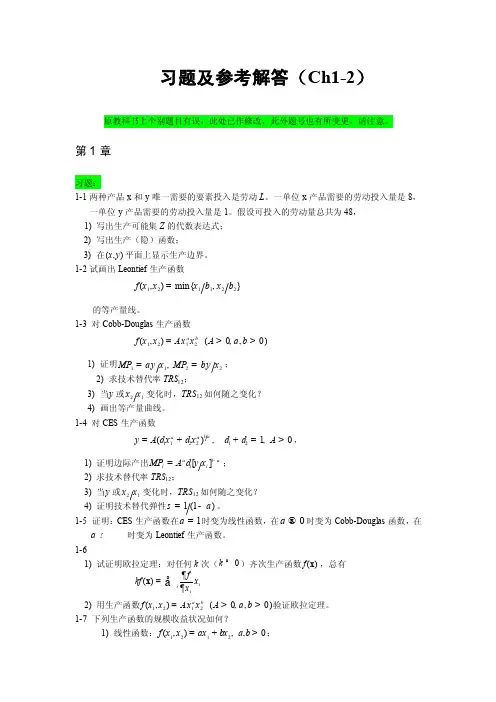
习题及参考解答(Ch1-2)原教科书上个别题目有误,此处已作修改,此外题号也有所变更,请注意。
第1章习题:1-1两种产品x 和y 唯一需要的要素投入是劳动L 。
一单位x 产品需要的劳动投入量是8,一单位y 产品需要的劳动投入量是1。
假设可投入的劳动量总共为48, 1) 写出生产可能集Z 的代数表达式; 2) 写出生产(隐)函数; 3) 在(,)x y 平面上显示生产边界。
1-2试画出Leontief 生产函数121122(,)min{,}f x x x x b =的等产量线。
1-3 对Cobb-Douglas 生产函数1212(,)f x x A x x a b= (0,,0A a b >>)1) 证明1122,MP y MP y x a b ==; 2) 求技术替代率TRS 12;3) 当y 或21x 变化时,TRS 12如何随之变化? 4) 画出等产量曲线。
1-4 对CES 生产函数11122()y A x x aa a d d =+, 121,0A d d +=>,1) 证明边际产出1[]i i i MP A y x a a d -=; 2) 求技术替代率TRS 12;3) 当y 或21x x 变化时,TRS 12如何随之变化? 4) 证明技术替代弹性1)s a =-。
1-5 证明:CES 生产函数在1a =时变为线性函数,在0a ®时变为Cobb-Douglas 函数,在a ? 时变为Leontief 生产函数。
1-61) 试证明欧拉定理:对任何k 次(0k ³)齐次生产函数()f x ,总有()i i ifkf x x ¶=¶åx2) 用生产函数1212(,)f x x A x x a b= (0,,0A a b >>)验证欧拉定理。
1-7 下列生产函数的规模收益状况如何?1) 线性函数:1212(,),,0f x x ax bx a b =+>;2) Leontief 生产函数; 3) Cobb-Douglas 生产函数; 4) CES 生产函数。
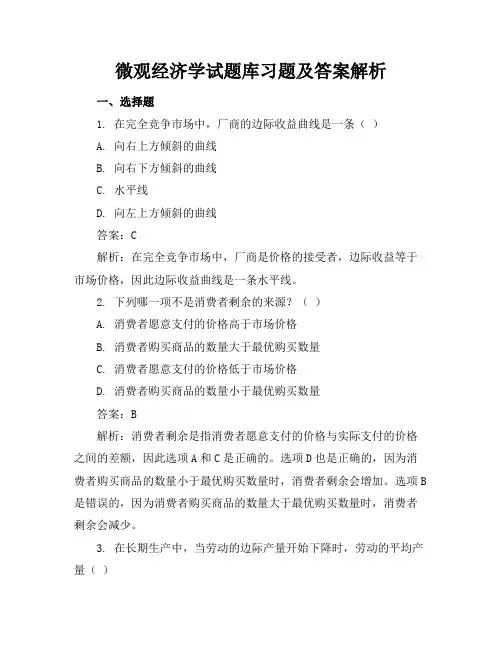
微观经济学试题库习题及答案解析一、选择题1. 在完全竞争市场中,厂商的边际收益曲线是一条()A. 向右上方倾斜的曲线B. 向右下方倾斜的曲线C. 水平线D. 向左上方倾斜的曲线答案:C解析:在完全竞争市场中,厂商是价格的接受者,边际收益等于市场价格,因此边际收益曲线是一条水平线。
2. 下列哪一项不是消费者剩余的来源?()A. 消费者愿意支付的价格高于市场价格B. 消费者购买商品的数量大于最优购买数量C. 消费者愿意支付的价格低于市场价格D. 消费者购买商品的数量小于最优购买数量答案:B解析:消费者剩余是指消费者愿意支付的价格与实际支付的价格之间的差额,因此选项A和C是正确的。
选项D也是正确的,因为消费者购买商品的数量小于最优购买数量时,消费者剩余会增加。
选项B 是错误的,因为消费者购买商品的数量大于最优购买数量时,消费者剩余会减少。
3. 在长期生产中,当劳动的边际产量开始下降时,劳动的平均产量()A. 仍然上升B. 开始下降C. 不变D. 无法确定答案:A解析:在长期生产中,劳动的边际产量开始下降时,劳动的平均产量仍然上升,因为平均产量是总产量除以劳动数量,而总产量在边际产量开始下降之前是增加的。
4. 下列哪一项不是完全竞争市场的特征?()A. 市场上有大量的买者和卖者B. 产品具有同质性C. 市场进入和退出自由D. 市场存在价格领导答案:D解析:完全竞争市场的特征包括:市场上有大量的买者和卖者、产品具有同质性、市场进入和退出自由。
市场不存在价格领导,因为价格是由市场供求关系决定的。
5. 下列哪一项不是规模经济的原因?()A. 专业化生产B. 技术进步C. 管理效率提高D. 市场垄断答案:D解析:规模经济的原因包括:专业化生产、技术进步、管理效率提高。
市场垄断不是规模经济的原因,因为垄断会导致市场效率降低。
二、简答题1. 简述边际效用递减规律。
答案:边际效用递减规律是指在其他条件不变的情况下,随着消费者对某种商品消费量的增加,每增加一单位消费量所获得的满足程度逐渐减少。
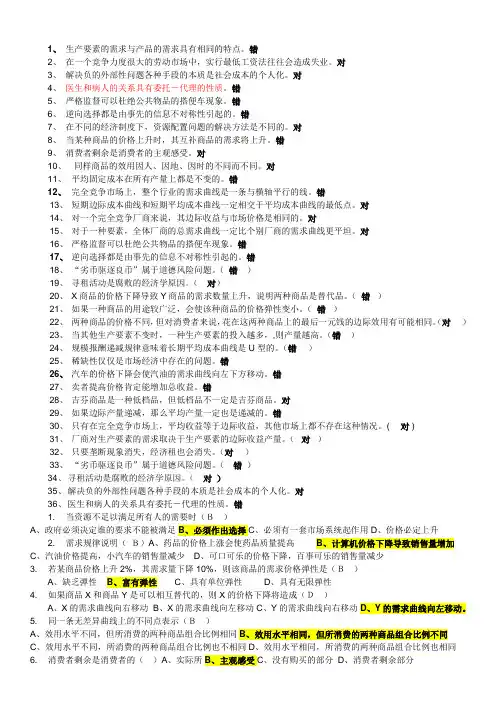
1、生产要素的需求与产品的需求具有相同的特点。
错2、在一个竞争力度很大的劳动市场中,实行最低工资法往往会造成失业。
对3、解决负的外部性问题各种手段的本质是社会成本的个人化。
对4、医生和病人的关系具有委托-代理的性质。
错5、严格监督可以杜绝公共物品的搭便车现象。
错6、逆向选择都是由事先的信息不对称性引起的。
错7、在不同的经济制度下,资源配置问题的解决方法是不同的。
对8、当某种商品的价格上升时,其互补商品的需求将上升。
错9、消费者剩余是消费者的主观感受。
对10、同样商品的效用因人、因地、因时的不同而不同。
对11、平均固定成本在所有产量上都是不变的。
错12、完全竞争市场上,整个行业的需求曲线是一条与横轴平行的线。
错13、短期边际成本曲线和短期平均成本曲线一定相交于平均成本曲线的最低点。
对14、对一个完全竞争厂商来说,其边际收益与市场价格是相同的。
对15、对于一种要素,全体厂商的总需求曲线一定比个别厂商的需求曲线更平坦。
对16、严格监督可以杜绝公共物品的搭便车现象。
错17、逆向选择都是由事先的信息不对称性引起的。
错18、“劣币驱逐良币”属于道德风险问题。
(错)19、寻租活动是腐败的经济学原因。
(对)20、 X商品的价格下降导致Y商品的需求数量上升,说明两种商品是替代品。
(错)21、如果一种商品的用途较广泛,会使该种商品的价格弹性变小。
(错)22、两种商品的价格不同,但对消费者来说,花在这两种商品上的最后一元钱的边际效用有可能相同。
(对)23、当其他生产要素不变时,一种生产要素的投入越多,,则产量越高。
(错)24、规模报酬递减规律意味着长期平均成本曲线是U型的。
(错)25、稀缺性仅仅是市场经济中存在的问题。
错26、汽车的价格下降会使汽油的需求曲线向左下方移动。
错27、卖者提高价格肯定能增加总收益。
错28、吉芬商品是一种低档品,但低档品不一定是吉芬商品。
对29、如果边际产量递减,那么平均产量一定也是递减的。
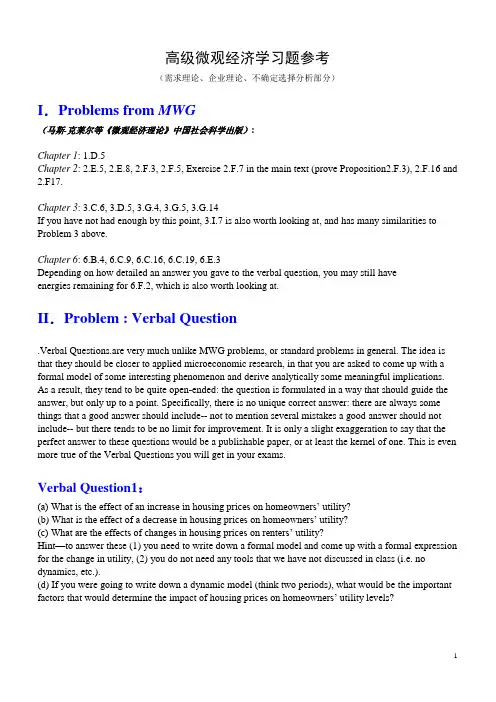
高级微观经济学习题参考(需求理论、企业理论、不确定选择分析部分)I.Problems from MWG(马斯-克莱尔等《微观经济理论》中国社会科学出版):Chapter 1: 1.D.5Chapter 2: 2.E.5, 2.E.8, 2.F.3, 2.F.5, Exercise 2.F.7 in the main text (prove Proposition2.F.3), 2.F.16 and 2.F17.Chapter 3: 3.C.6, 3.D.5, 3.G.4, 3.G.5, 3.G.14If you have not had enough by this point, 3.I.7 is also worth looking at, and has many similarities to Problem 3 above.Chapter 6: 6.B.4, 6.C.9, 6.C.16, 6.C.19, 6.E.3Depending on how detailed an answer you gave to the verbal question, you may still haveenergies remaining for 6.F.2, which is also worth looking at.II.Problem : Verbal Question.Verbal Questions.are very much unlike MWG problems, or standard problems in general. The idea is that they should be closer to applied microeconomic research, in that you are asked to come up with a formal model of some interesting phenomenon and derive analytically some meaningful implications. As a result, they tend to be quite open-ended: the question is formulated in a way that should guide the answer, but only up to a point. Specifically, there is no unique correct answer: there are always some things that a good answer should include-- not to mention several mistakes a good answer should not include-- but there tends to be no limit for improvement. It is only a slight exaggeration to say that the perfect answer to these questions would be a publishable paper, or at least the kernel of one. This is even more true of the Verbal Questions you will get in your exams.Verbal Question1:(a) What is the effect of an increase in housing prices on homeowners’ utility?(b) What is th e effect of a decrease in housing prices on homeowners’ utility?(c) What are the effects of changes in housing prices on renters’ utility?Hint—to answer these (1) you need to write down a formal model and come up with a formal expression for the change in utility, (2) you do not need any tools that we have not discussed in class (i.e. no dynamics, etc.).(d) If you were going to write down a dynamic model (think two periods), what would be the important factors that would determine the impact of housing p rices on homeowners’ utility levels?Sketch of an Answer to the Verbal Question1Verbal Question2:The parvenus’ utility (and marginal utility) from consumption of good Z is increasing in the average consumption of good Z by the aristocrats. The aristocrats’ utility (and marginal utility) from consumption of good Z is decreasing in the average consumption of good Z by the parvenus.a) Describe the static equilibrium and derive comparative statics of demand with respect to price. Which group will have a bigger response to price? What is the optimal government policy?b) Now assume that the parvenus are perpetually out of date, and care only about consumption of the aristocrats last period. The aristocrats instead know what is going on and care about consumption of the parvenus today. Characterize the equilibria and derive comparative statics. In particular, derive conditions under which you can get cycles. What implications can you draw for public policy?Sketch of an Answer to the Verbal Question2Verbal Question3:Assume that there are farmers and fishermen in a closed community. With some probability there is a drought that impacts farmers’ income, but not that of fishermen.a) Derive the price of a security that pays off in the event of a drought—note that, in a closed community, this security needs to be sold by fishermen to farmers. How will the price of this asset change with the share of the population that farms, the probability the drought and its severity? What about the incomes of farmers and fishermen? Also derive the consumption patterns of the groups in the two states of the world in the general case, and in the case of a power utility function—can you get any new (or better) comparative statics after specifying the functional form?b) Now assume that the fishermen also face a stochastic negative shock that reduces their income, and assume that there exists a security that pays off in the case of this shock. What happens in the case where the shocks are perfectly negatively correlated? (You may want to use the power utility function). What determines the price of the securities and overall consumption in the case where the two shocks are imperfectly correlated?c) To generalize, you may want to consider a continuum of professions, each potentially hit by an idiosyncratic shock, with securities that pay off in the event of each shock. What can you say about the pricing of these securities and the overall pattern of consumption for members of different professions?Sketch of an Answer to the Verbal Question3:。
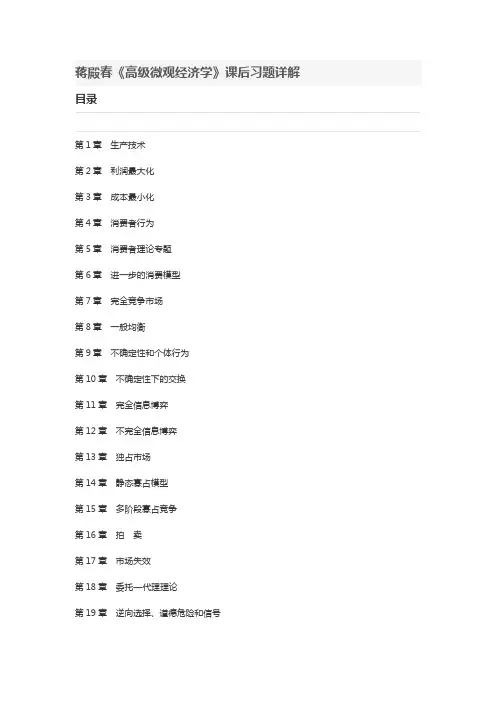
蒋殿春《高级微观经济学》课后习题详解目录第1章生产技术第2章利润最大化第3章成本最小化第4章消费者行为第5章消费者理论专题第6章进一步的消费模型第7章完全竞争市场第8章一般均衡第9章不确定性和个体行为第10章不确定性下的交换第11章完全信息博弈第12章不完全信息博弈第13章独占市场第14章静态寡占模型第15章多阶段寡占竞争第16章拍卖第17章市场失效第18章委托—代理理论第19章逆向选择、道德危险和信号本书是蒋殿春《高级微观经济学》教材的学习辅导书,对蒋殿春《高级微观经济学》教材每章的课后习题进行了详细的分析和解答,并对个别知识点进行了扩展。
课后习题答案久经修改,质量上乘,特别适合应试作答和复习参考。
资料下载地址:/Ebook/11708.html来源:【弘博学习网】或关注公众号【hbky96】获取更多学习资料。
第1章生产技术1两种产品和唯一需要的要素投入是劳动。
一单位产品需要的劳动投入量是8,一单位产品需要的劳动投入量是1。
假设可投入的劳动量总共为48。
(1)写出生产可能集的代数表达式;(2)写出生产(隐)函数;(3)在平面上标示生产边界。
解:(1)由题意可知,总量为48,劳动是两种产品唯一需要的要素投入,所以有:因此,生产可能集的代数表达式为。
(2)一单位产品需要的劳动投入量是8,一单位产品需要的劳动投入量是1,所以生产(隐)函数为。
(3)由(1)可得,生产可能集为,如图1-1所示。
图1-12试画出Leontief生产函数的等产量线。
解:由Leontief生产函数表达式可知,当时,,由此可得到其等产量线如图1-2所示。
图1-23对Cobb-Douglas生产函数(1)证明,。
(2)求技术替代率。
(3)当或变化时,如何随之变化?(4)画出等产量曲线。
解:(1)已知生产函数,即,所以有:即得证。
(2)在(1)中已经证明,,因此,技术替代率为:在Cobb-Douglas生产函数中,整理得。
(3)由(2)可知,,技术替代率与无关,不随的变化而变化;而变化时,技术替代率随之等比例变化。
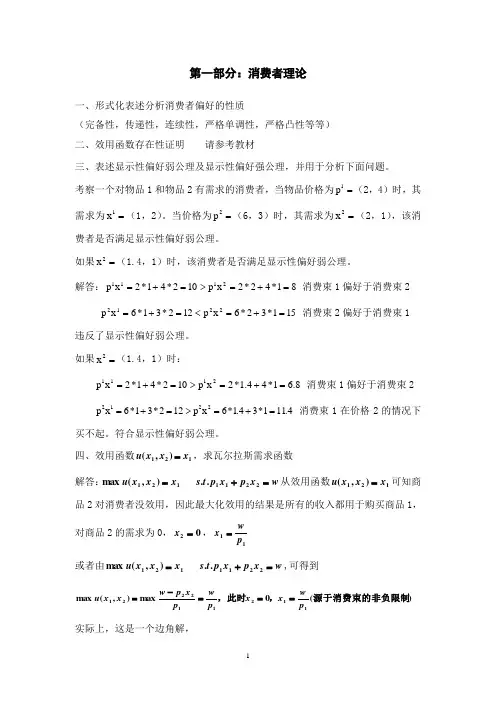
第一部分:消费者理论一、形式化表述分析消费者偏好的性质(完备性,传递性,连续性,严格单调性,严格凸性等等) 二、效用函数存在性证明 请参考教材三、表述显示性偏好弱公理及显示性偏好强公理,并用于分析下面问题。
考察一个对物品1和物品2有需求的消费者,当物品价格为=1p (2,4)时,其需求为=1x (1,2)。
当价格为=2p (6,3)时,其需求为=2x (2,1),该消费者是否满足显示性偏好弱公理。
如果=2x (1.4,1)时,该消费者是否满足显示性偏好弱公理。
解答:81*42*2x p 102*41*2x p 2111=+=>=+= 消费束1偏好于消费束2 151*32*6x p 122*31*6x p 2212=+=<=+= 消费束2偏好于消费束1 违反了显示性偏好弱公理。
如果=2x (1.4,1)时:8.61*44.1*2x p 102*41*2x p 2111=+=>=+= 消费束1偏好于消费束2 2122p x 6*13*212p x 6*1.43*111.4=+=>=+= 消费束1在价格2的情况下买不起。
符合显示性偏好弱公理。
四、效用函数121),(x x x u =,求瓦尔拉斯需求函数 解答:w x p x p t s x x x u =+=2211121..),(max 从效用函数121),(x x x u =可知商品2对消费者没效用,因此最大化效用的结果是所有的收入都用于购买商品1,对商品2的需求为0,02=x ,11p wx = 或者由w x p x p t s x x x u =+=2211121..),(max ,可得到)(0max),(max 112112221源于消费束的非负限制,,此时p wx x p w p x p w x x u ===-= 实际上,这是一个边角解,五、效用函数ρρρ12121)(),(x x x x u +=,对其求 1、瓦尔拉斯需求函数,间接效用函数; 2、希克斯需求函数,支出函数。
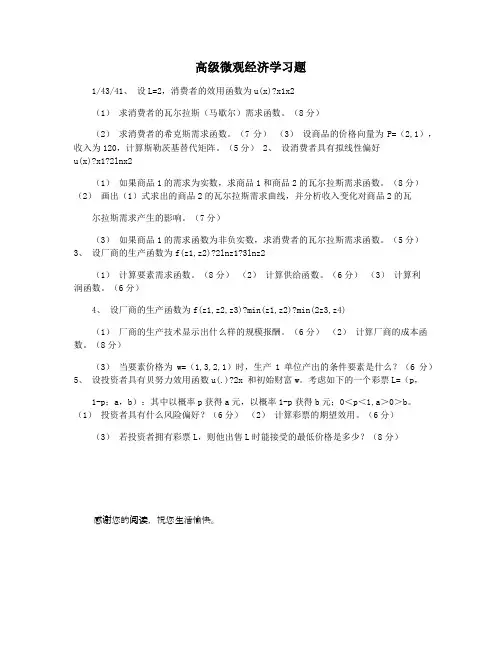
高级微观经济学习题1/43/41、设L=2,消费者的效用函数为u(x)?x1x2(1)求消费者的瓦尔拉斯(马歇尔)需求函数。
(8分)(2)求消费者的希克斯需求函数。
(7分)(3)设商品的价格向量为P=(2,1),收入为120,计算斯勒茨基替代矩阵。
(5分) 2、设消费者具有拟线性偏好u(x)?x1?2lnx2(1)如果商品1的需求为实数,求商品1和商品2的瓦尔拉斯需求函数。
(8分)(2)画出(1)式求出的商品2的瓦尔拉斯需求曲线,并分析收入变化对商品2的瓦尔拉斯需求产生的影响。
(7分)(3)如果商品1的需求函数为非负实数,求消费者的瓦尔拉斯需求函数。
(5分)3、设厂商的生产函数为f(z1,z2)?2lnz1?3lnz2(1)计算要素需求函数。
(8分)(2)计算供给函数。
(6分)(3)计算利润函数。
(6分)4、设厂商的生产函数为f(z1,z2,z3)?min(z1,z2)?min(2z3,z4)(1)厂商的生产技术显示出什么样的规模报酬。
(6分)(2)计算厂商的成本函数。
(8分)(3)当要素价格为w=(1,3,2,1)时,生产1单位产出的条件要素是什么?(6分)5、设投资者具有贝努力效用函数u(.)?2x 和初始财富w。
考虑如下的一个彩票L=(p,1-p;a,b):其中以概率p获得a元,以概率1-p获得b元;0<p<1,a>0>b。
(1)投资者具有什么风险偏好?(6分)(2)计算彩票的期望效用。
(6分)(3)若投资者拥有彩票L,则他出售L时能接受的最低价格是多少?(8分)感谢您的阅读,祝您生活愉快。
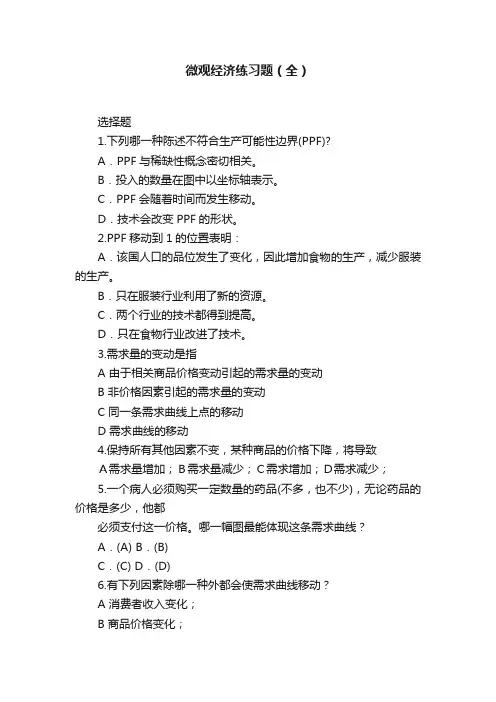
微观经济练习题(全)选择题1.下列哪一种陈述不符合生产可能性边界(PPF)?A.PPF与稀缺性概念密切相关。
B.投入的数量在图中以坐标轴表示。
C.PPF会随着时间而发生移动。
D.技术会改变PPF的形状。
2.PPF移动到1的位置表明:A.该国人口的品位发生了变化,因此增加食物的生产,减少服装的生产。
B.只在服装行业利用了新的资源。
C.两个行业的技术都得到提高。
D.只在食物行业改进了技术。
3.需求量的变动是指A 由于相关商品价格变动引起的需求量的变动B 非价格因素引起的需求量的变动C 同一条需求曲线上点的移动D 需求曲线的移动4.保持所有其他因素不变,某种商品的价格下降,将导致A需求量增加;B需求量减少;C需求增加;D需求减少;5.一个病人必须购买一定数量的药品(不多,也不少),无论药品的价格是多少,他都必须支付这一价格。
哪一幅图最能体现这条需求曲线?A.(A) B.(B)C.(C) D.(D)6.有下列因素除哪一种外都会使需求曲线移动?A 消费者收入变化;B 商品价格变化;C 消费者偏好变化;D 其他相关商品价格变化。
7.某种商品价格下降对其互补品的影响是()。
A 互补品的需求曲线向左移动;B 互补品的需求曲线向右移动;C 互补品的供给曲线向右移动;D 互补品的价格上升。
8.某一时期,电冰箱的供给曲线向右移动的原因可以是()A 电冰箱的价格下降B 生产者对电冰箱的预期价格上升C 生产冰箱的要素成本上升D 消费者的收入上升9.下列哪中情况不正确?()A 如果供给减少,需求不变,均衡价格将上升;B 如果供给增加,需求减少,均衡价格将下降;C 如果需求增加,供给减少,均衡价格将上升;D 如果需求减少,供给增加,均衡价格将上升。
10.需求的价格弹性是指()。
A 需求函数的斜率;B 收入变化对需求的影响程度;C 消费者对价格变化的反映程度;D 以上说法都正确。
11.当某消费者的收入上升20%,其对某商品的需求量上升5%,则商品的需求收入弹性A 大于1B 小于1C 等于1D 等于012.假定Gray先生拿一笔固定的钱购买鸡蛋。
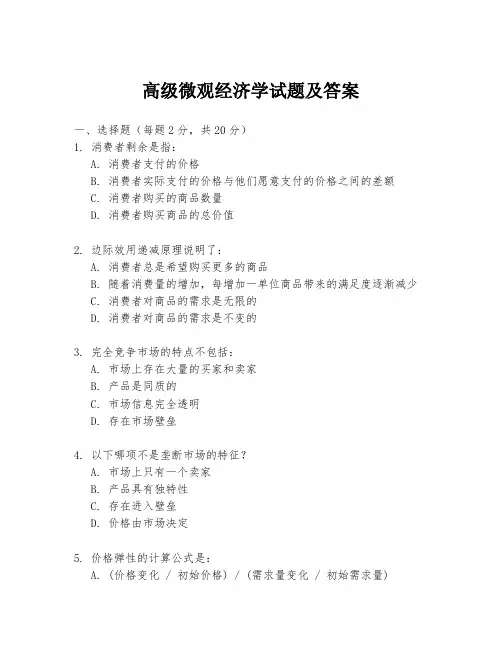
高级微观经济学试题及答案一、选择题(每题2分,共20分)1. 消费者剩余是指:A. 消费者支付的价格B. 消费者实际支付的价格与他们愿意支付的价格之间的差额C. 消费者购买的商品数量D. 消费者购买商品的总价值2. 边际效用递减原理说明了:A. 消费者总是希望购买更多的商品B. 随着消费量的增加,每增加一单位商品带来的满足度逐渐减少C. 消费者对商品的需求是无限的D. 消费者对商品的需求是不变的3. 完全竞争市场的特点不包括:A. 市场上存在大量的买家和卖家B. 产品是同质的C. 市场信息完全透明D. 存在市场壁垒4. 以下哪项不是垄断市场的特征?A. 市场上只有一个卖家B. 产品具有独特性C. 存在进入壁垒D. 价格由市场决定5. 价格弹性的计算公式是:A. (价格变化 / 初始价格) / (需求量变化 / 初始需求量)B. (需求量变化 / 初始需求量) / (价格变化 / 初始价格)C. (价格变化 / 初始价格) * (需求量变化 / 初始需求量)D. (需求量变化 / 初始需求量) * (初始价格 / 价格变化)6. 以下哪个选项是正确的消费者需求曲线?A. 垂直线B. 水平线C. 向右下倾斜的线D. 向右上倾斜的线7. 以下哪个选项是正确的生产者供给曲线?A. 垂直线B. 水平线C. 向右上倾斜的线D. 向右下倾斜的线8. 边际成本与平均成本的关系是:A. 边际成本总是高于平均成本B. 边际成本总是低于平均成本C. 边际成本与平均成本相等时,平均成本达到最低点D. 边际成本与平均成本没有关系9. 以下哪个选项是正确的市场均衡价格?A. 仅由消费者决定B. 仅由生产者决定C. 由消费者和生产者共同决定D. 由政府决定10. 以下哪个选项是正确的帕累托效率?A. 至少有一个人可以变得更好而不使其他人变得更糟B. 至少有一个人可以变得更糟而不使其他人变得更好C. 没有人可以变得更好而不使其他人变得更糟D. 没有人可以变得更糟而不使其他人变得更好二、简答题(每题10分,共30分)1. 简述边际效用递减原理,并举例说明其在日常生活中的应用。
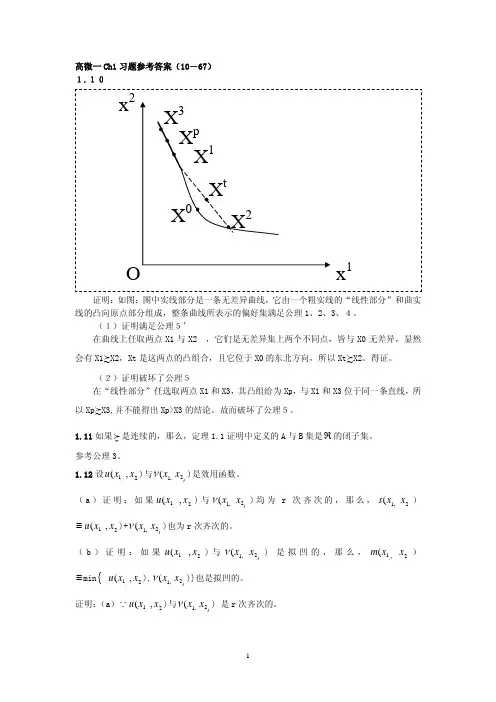
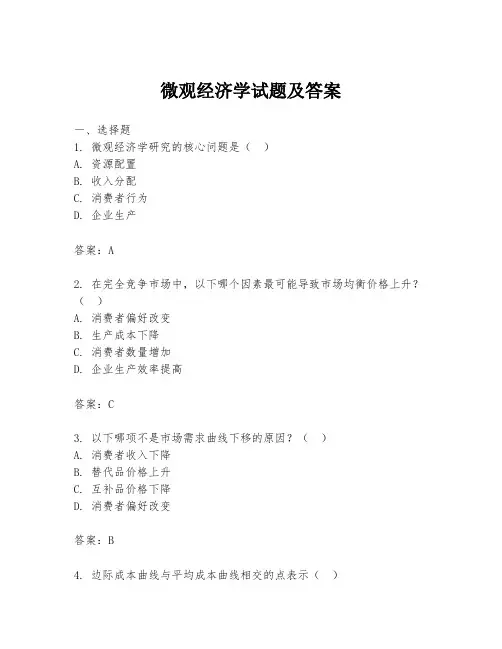
微观经济学试题及答案一、选择题1. 微观经济学研究的核心问题是()A. 资源配置B. 收入分配C. 消费者行为D. 企业生产答案:A2. 在完全竞争市场中,以下哪个因素最可能导致市场均衡价格上升?()A. 消费者偏好改变B. 生产成本下降C. 消费者数量增加D. 企业生产效率提高答案:C3. 以下哪项不是市场需求曲线下移的原因?()A. 消费者收入下降B. 替代品价格上升C. 互补品价格下降D. 消费者偏好改变答案:B4. 边际成本曲线与平均成本曲线相交的点表示()A. 企业亏损B. 企业盈利C. 企业生产最小化D. 企业生产最大化答案:B5. 如果一家公司的边际收益递减,那么()A. 总收益递增但增速放缓B. 总收益递减C. 边际成本递增D. 平均成本递减答案:A二、填空题1. 在微观经济学中,________是指在其他条件不变的情况下,一种商品价格变动所引起的该商品需求量变动的百分比与价格变动的百分比之比。
答案:价格弹性2. 当_________存在时,企业可以通过增加产量来降低单位成本。
答案:规模经济3. 在市场经济中,_________是指消费者愿意并且能够购买的商品或服务的数量。
答案:需求4. 微观经济学中的_________理论解释了企业如何决定生产多少商品以及如何定价。
答案:利润最大化5. 当市场上只有一个买家和多个卖家时,这种市场结构被称为_________。
答案:单买寡卖三、简答题1. 简述需求定律的内容及其在市场经济中的作用。
答案:需求定律指出,在其他条件不变的情况下,商品的价格与其需求量成反比,即价格上升时需求量下降,价格下降时需求量上升。
这一定律在市场经济中的作用主要体现在帮助生产者和消费者做出决策,如调整生产量和定价策略,以及预测市场变化等。
2. 描述边际成本与平均成本之间的关系。
答案:边际成本是指生产额外一单位产品所增加的成本,而平均成本是指单位产品的平均成本。
在生产过程中,随着产量的增加,边际成本会先降低后上升,这是因为规模经济效应使得单位成本降低,但当超过某一点后,由于拥挤效应等因素,单位成本会上升。
微观经济学练习题一一、判断题1.微观经济学研究的是个量经济问题。
()2.序数效用论分析消费者均衡运用的是边际效用分析方法. ()3.吉芬物品的需求曲线是“倒"需求曲线(价格与需求同向变化)。
( )4.市场均衡状态是供给与需求相等的状态。
( )5.离原点约远的无差异曲线,代表的效用水平越低. ()6.微观经济学中,生产者的目标是效用最大化. ( )7.生产函数为Q = 0.5L0.6K0.5时,厂商处于规模报酬不变的状态. ()8.厂商短期生产的第三阶段是劳动的边际产量(报酬)为负的阶段。
()9.短期成本变动的决定因素是:边际收益递减规律。
()10.外在不经济会使企业的LAC向上方移动. ()11.面临两条需求曲线的是寡头厂商。
()12.斯威齐模型又被称为“拐折的需求曲线模型”。
( )13.完全竞争厂商对要素(以劳动为例)的需求原则是:VMP = W . ()14.存在帕累托改进的资源配置状态也可能是资源配置的帕累托最优状态。
()15.不具有排他性和竞用性的物品叫做公共资源。
( )二、单项选择题1.经济学的基本问题是:()A.个体经济单位 B.社会福利C.利润最大化 D.资源稀缺性2.墨盒的价格上升会使打印机的需求:()A.不变 B.上升 C.下降 D.不能确定3.需求曲线右移,表示在同一价格水平下供给( )A.增加 B.减少 C.不变 D.不能确定收入增加的同时,4.以下关于价格管制说法不正确的是:( )A.限制价格总是低于市场的均衡价格B.支持价格总是高于市场均衡价格C.只要价格放开,商品的供给就会增加D.对农产品而言,为防止“谷贱伤农”,可使用支持价格的策略5.商品在消费者支出中所占的比重越高,则商品的需求弹性( )A.越小 B.越大 C.与之无关 D.不确定有无关联6.需求缺乏弹性的商品( )会增加销售收入A.提高价格 B.降低价格 C.提价和降价都 D.提价和降价都不会7.离原点越远的等产量曲线代表的产量水平( )A.越不能达到 B.越不能确定 C.越低 D.越高8.边际产量(报酬)递增的阶段,往往对应的是厂商( )的阶段A.规模报酬递减 B.规模报酬递增C.规模报酬不变 D.规模报酬如何不能判断9.决定TP L曲线的形状特点的是( )递减规律A.边际效用 B.边际产量 C.边际技术替代率 D.边际替代10.同一坐标平面内的两条等产量曲线:( )A.永不相交 B.一定相交 C.相交与否不确定 D.相交与否取决于厂商11.生产者的均衡条件是( )A.MC = MR B.AC = MR C.AC=MC D.AP = MP12.完全竞争厂商处于长期均衡时:()A.处于LMC的最低点 B.产量最大C.处于生产的停产点 D.LMC = LAC13.竞争最公平的是()市场A.完全竞争 B.寡头 C.垄断竞争 D.垄断14.垄断厂商实施一级价格歧视会占有()的消费者剩余A.100% B.50% C.50% D.不同市场不同比率的15.以下属于“引致需求”的是:()A.居民对绿地的需求 B.儿童对教育的需求 C.补鞋者对胶水的需求 D.人对水的需求16.完全竞争厂商使用生产要素的“边际收益”是:()A.MP B.MRS C.MC D.VMP17.基尼系数越高,收入分配越( )A.平等 B.不平等 C.难以确定是否平等 D.与其无关18.以下关于一般均衡(分析)与局部均衡(分析)的说法不正确的是:()A.局部均衡分析把市场“抽出”来单独研究B.把皮鞋市场与皮革市场联系考察,得到均衡的就是一般均衡C.无论是一般均衡还是局部均衡,主要都属于实证经济学的部分D.法国经济学家里昂.瓦尔拉斯最先充分认识到一般均衡问题的重要性19.交换的帕累托最优条件是:( )A.MRS XY= MRT XY B.MRT A XY = MRT B XYC.MRS A XY = MRS B XY D.MRS XY = MRT LK20.解决效率与公平问题的普遍思路是:( )A.效率与公平并重 B.公平为基础,效率后行C.谁重要,以实现社会福利的增加为决定因素 D.效率优先,兼顾公平三、多项选择题1.微观经济学的基本假设包括:()A.经济人 B.利己主义的人C.完全信息 D.公平竞争2.以下会使圆珠笔供给增加的有:( )A.生产者税收增加 B.纸张价格下降C.生产圆珠笔的技术提高D.圆珠笔油墨价格下降3.以下关于消费者均衡的均衡条件:MRS X1X2 =P X1/P X2说法正确的有:()A.当 MRS X1X2>P X1/P X2时,应该增加X1的消费,减少X2的消费B.表示在维持同等效用水平的条件下,增加一单位X1的消费所能替代的X2的消费数量>市场价格决定的一单位X1所能替代出来的X2量C.几何意义是无差异曲线与等成本线的切点D.也可以说,该均衡状态表示既定预算下的最大效用满足状态4.以下关于成本的说法正确的有:()A.TFC是总固定成本B.LMC与LAC相交于LAC的最低点C.SAC=AFC+AVCD.MC一般总是先减少后增加5.对商品的市场价格有控制能力的有()厂商A.垄断 B.寡头 C.垄断竞争 D.完全竞争四、简答题1.影响需求的因素有哪些?2.什么是边际技术替代率递减规律?它决定了哪条曲线的什么特点?3.什么是规模经济(报酬)?有那几种情况?4.完全竞争厂商的短期均衡状态有哪几种情况?5.市场失灵的原因有哪些?(6分)6.为什么完全竞争的市场被称为“最好的市场”?(7分)五、计算题1.假定有供给函数Q d = 1200 — 200P(1)求出价格2元和4元之间的需求的价格弧弹性(2分)(2)根据给出的需求函数,P =5元时的需求的价格点弹性(2分)2.已知某消费者每月用400元购买两类食品:粮食X1,平均每磅4元,蔬菜X2,平均每磅2元(1)写出预算方程,并画出他的预算线(2分)(2)如果他的效用函数为U(X1,X2)= X1.X2,为使效用最大化,该消费者应分别购买多少X1、X2?(3分)3.在一个完全竞争的行业中单个厂商的长期总成本函数为:LTC = Q3-20Q2 + 200Q,市场的产品价格为P =600。
邢祖礼老师的高级微观经济学作业(2008)1、假设市场上有两个消费者,他们的个人需求函数分别为 :1()20D p p =-和2()10D p p =-。
试求市场需求函数。
2、某种商品的市场需求曲线为D P P D D ()=-1002,供给曲线为S P P S S ()=3。
(1) 假定政府对商品征收5元的数量税,均衡的数量和价格(S P 和D P )将是多少?(2) 计算税收的额外净损失。
3、已知某市场商品的需求方程是180d p Q =-,供给方程是160s p Q =+,求均衡价格与产量各是多少?政府补贴50元后,均衡产量、均衡价格、生产者实际得到的总价格、消费者实际支付的净价格是多少?4、如果某行业中典型企业的利润函数是:2(,);16ip k p k k π=-:市场需求为 294/Q p =,k 为资本规模,求:(1)典型企业的供给函数i q ;(2)长期均衡价格;(3)证明:行业中单个企业的资本规模k 会与行业中存在的企业个数成反比。
5、在一个完全竞争的市场上,有100位完全相同的消费者,每个人的效用函数为2(,)2x u x y x y =-+,其中x y 和分别为两种商品的数量,x 的价格为p ,y 的价格为1,消费者的收入为比较大的某个值m 。
(1)写出对x 的市场需求函数;(2)假定市场中有若干个具有相同生产技术的厂商,每个厂商的成本函数为2()116q c q =+,请问均衡时,该行业中有多少个厂商?市场均衡价格和产量分别是多少?6、有一种两个消费者、两种物品的交换经济,消费者的效用函数和禀赋如下:}{112122(,)min ,(,)u x x x x v p y == 12(30,0)(0,20)e e ==。
(1)求解瓦尔拉斯一般均衡;(2)如果禀赋状态为12(5,0),(0,2)e e ==,重新计算一般均衡。
7、在一个岛上,有200公斤粮食在两个人之间进行分配。
微观经济学考试题+参考答案一、单选题(共100题,每题1分,共100分)1.某完全竞争厂商的销售量Q=10,单价P=8,其总变动成本为60,则生产者剩余为( )。
A、20B、140。
C、60D、80正确答案:A2.边际成本低于平均成本时,( )。
A、平均成本上升B、平均可变成本可能上升也可能上升也可能下降C、总成本下降D、平均可变成本上升。
正确答案:B答案解析:当边际成本低于平均成本时,说明新增生产的单位成本低于平均成本,这可能是因为新增生产的单位产量较少,而固定成本已经分摊到之前的产量中,因此平均成本会上升。
但是,新增生产的单位成本低于平均成本,说明新增生产的单位可变成本也低于平均可变成本,因此平均可变成本可能上升也可能下降。
总成本下降的情况不太可能出现,因为新增生产的单位成本低于平均成本,但是总成本仍然包括之前的固定成本,因此总成本不太可能下降。
因此,选项B是正确的。
3.经济学中短期成本与长期成本的划分是取决于( )。
A、时间的长短B、是否可以调整生产规模。
C、是否可以调整产品价格D、是否可以调整产量正确答案:B4.某消费者消费A、B两种商品,假定消费者的收入增加了一倍,同时两种商品的价格也提高了一倍,该消费者的预算线将( )。
A、向外平移但斜率不变B、向外移动但更陡峭C、向外移动但更平缓D、不变。
正确答案:D5.已知消费者的收入是lOO元,商品X的价格是10元,商品Y的价格是3元。
假定他打算购买7单位X和10单位Y,这时商品X和Y的边际效用分别是50和18。
如要获得最大效用,他应该( )。
A、同时增购X和Y。
B、增购X、减少Y的购买量C、停止购买D、减少X的购买量,增购Y正确答案:D6.垄断企业面对的需求函数为Q=100/ P2,企业的边际成本始终为1,垄断价格为( )。
A、1B、2C、5D、10。
正确答案:B答案解析:垄断企业的利润最大化条件为边际收益等于边际成本。
由需求函数可得,总收益为PQ=100/P。
最新高级微观经济学试题练习_ONLY题目(新题标记版)《高级微观经济学》习题1.一个凸的、单调偏好的消费者消费非负数量的12,x x :(1)如果121212/(,)a au x x x x -=代表其偏好,那么,对参数值a 的取值有什么限制?请解释。
(2)给定这些约束,计算马歇尔需求函数2.已知柯布-道格拉斯效用函数11212αα(,)u x x x x -=,试回答下列问题:(1)导出马歇尔需求函数(,)x p m 和间接效用函数(,)v p m ,并验证罗伊恒等式(2)验证(,)x p m 在(,)p m 上是零阶齐次的(2)验证(,)x p m 满足瓦尔拉斯定律(3)验证(,)v p m 在(,)p m 上是零阶齐次的(4)验证(,)v p m 在(,)p m 上是拟凹的3.已知 CES 效用函数ρρρ12121x x x x u )(),(+=(10<≠ρ),试回答下列问题:(1)导出的希克斯需求函数(,)h p u 和支出函数(,)e p u ,并验证谢泼德引理(2)验证(,)h p u 在p 上是零次齐次的(3)验证(,)h p u 满足((,))u h p u u =,即没有超额效用(4)验证(,)e p u 在p 上是一次齐次的(5)验证(,)e p u 在u 上是严格递增的(6)验证(,)e p u 在p 上是凹的4.考察下式给出的间接效用函数:1212(,,)mv p p m p p =+,求:(1)马歇尔需求函数(2)支出函数(3)直接效用函数5.(,)i x p m 是消费者对商品i 的马歇尔需求函数(1,...,i k =),其需求收入弹性和需求需求交叉价格弹性分别为:i i i x m m x η?=,j i ij j ipx p x γ?=?,试证明:(1)恩格尔加总规则:11ki i i s η==∑,这里/i i i s p x m =(2)古诺加总规则:1ki ij i s s γ==-∑6.令斯卢茨基方程右端第一项h i j x p ??为ij s ,ij s 为i x 和j x 的净替代效应,设效用函数为12r u x x =,试证明:1111220s p s p +=7.某人的效应函数是1212(,)u x x x x =,他的收入100m =。
例题1:马歇尔需求
函数1/1212(,)()u x x x x ρρρ=+被称为CES 效用函数,其中01ρ≠<。
容易证明,该效用函数
代表着严格单调且严格凸的偏好。
消费者问题是找到一个非负的消费组合作为如下问题的解.
例题2:间接效用函数。
在例题1.1中,直接效用函数是CES 形式的,1/1212(,)()u x x x x ρρρ=+,其中,01ρ≠<,
马歇尔需求为:
可以验证,该函数具有间接效用函数的全部性质。
例题3:求支出函数
直接效用函数是CES 形式的,1/1212(,)()p u x x x x ρρ=+。
支出最小化问题为:
例题4:马歇尔需求和希克斯需求之间的对偶性。
根据例题3
(E.3)中最后一个表达式的右侧给出了马歇尔需求,这也是我们在例题1.1的效用最大化问题中求出来的结果。
定理1.9的第一个式子得证。
接下来证明第二个等式。
假设我们已经从例题1中得到了马歇尔需求:
最后一个式子的右侧给出了希克斯需求,这也是我们在例题1.3中通过求解消费者的支出最小化问题而直接得到的一个结果。
需求函数的性质。
高级微观经济学习题参考(需求理论、企业理论、不确定选择分析部分)I.Problems from MWG(马斯-克莱尔等《微观经济理论》中国社会科学出版):Chapter 1: 1.D.5Chapter 2: 2.E.5, 2.E.8, 2.F.3, 2.F.5, Exercise 2.F.7 in the main text (prove Proposition2.F.3), 2.F.16 and 2.F17.Chapter 3: 3.C.6, 3.D.5, 3.G.4, 3.G.5, 3.G.14If you have not had enough by this point, 3.I.7 is also worth looking at, and has many similarities to Problem 3 above.Chapter 6: 6.B.4, 6.C.9, 6.C.16, 6.C.19, 6.E.3Depending on how detailed an answer you gave to the verbal question, you may still haveenergies remaining for 6.F.2, which is also worth looking at.II.Problem : Verbal Question.Verbal Questions.are very much unlike MWG problems, or standard problems in general. The idea is that they should be closer to applied microeconomic research, in that you are asked to come up with a formal model of some interesting phenomenon and derive analytically some meaningful implications. As a result, they tend to be quite open-ended: the question is formulated in a way that should guide the answer, but only up to a point. Specifically, there is no unique correct answer: there are always some things that a good answer should include-- not to mention several mistakes a good answer should not include-- but there tends to be no limit for improvement. It is only a slight exaggeration to say that the perfect answer to these questions would be a publishable paper, or at least the kernel of one. This is even more true of the Verbal Questions you will get in your exams.Verbal Question1:(a) What is the effect of an increase in housing prices on homeowners’ utility?(b) What is th e effect of a decrease in housing prices on homeowners’ utility?(c) What are the effects of changes in housing prices on renters’ utility?Hint—to answer these (1) you need to write down a formal model and come up with a formal expression for the change in utility, (2) you do not need any tools that we have not discussed in class (i.e. no dynamics, etc.).(d) If you were going to write down a dynamic model (think two periods), what would be the important factors that would determine the impact of housing p rices on homeowners’ utility levels?Sketch of an Answer to the Verbal Question1Verbal Question2:The parvenus’ utility (and marginal utility) from consumption of good Z is increasing in the average consumption of good Z by the aristocrats. The aristocrats’ utility (and marginal utility) from consumption of good Z is decreasing in the average consumption of good Z by the parvenus.a) Describe the static equilibrium and derive comparative statics of demand with respect to price. Which group will have a bigger response to price? What is the optimal government policy?b) Now assume that the parvenus are perpetually out of date, and care only about consumption of the aristocrats last period. The aristocrats instead know what is going on and care about consumption of the parvenus today. Characterize the equilibria and derive comparative statics. In particular, derive conditions under which you can get cycles. What implications can you draw for public policy?Sketch of an Answer to the Verbal Question2Verbal Question3:Assume that there are farmers and fishermen in a closed community. With some probability there is a drought that impacts farmers’ income, but not that of fishermen.a) Derive the price of a security that pays off in the event of a drought—note that, in a closed community, this security needs to be sold by fishermen to farmers. How will the price of this asset change with the share of the population that farms, the probability the drought and its severity? What about the incomes of farmers and fishermen? Also derive the consumption patterns of the groups in the two states of the world in the general case, and in the case of a power utility function—can you get any new (or better) comparative statics after specifying the functional form?b) Now assume that the fishermen also face a stochastic negative shock that reduces their income, and assume that there exists a security that pays off in the case of this shock. What happens in the case where the shocks are perfectly negatively correlated? (You may want to use the power utility function). What determines the price of the securities and overall consumption in the case where the two shocks are imperfectly correlated?c) To generalize, you may want to consider a continuum of professions, each potentially hit by an idiosyncratic shock, with securities that pay off in the event of each shock. What can you say about the pricing of these securities and the overall pattern of consumption for members of different professions?Sketch of an Answer to the Verbal Question3:。